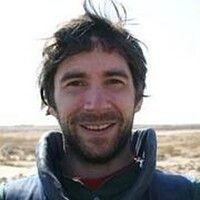Why would an American white supremacist be fond of Rhodesia?
Loading...
After the alleged gunman in the racially motivated terrorist attack on a historic black church in Charleston, S.C, was identified today, a picture was found of him wearing a jacket with two defunct national flag patches: Those of apartheid South Africa and Rhodesia.
The flags are popular in some white supremacist circles as a way to advertise to others in the know without being as obvious as wearing a swastika. And Dylann Storm Roof's choice of target could hardly send a stronger message of interest in white supremacy. The Emanuel African Methodist Episcopal congregation in Charleston was founded in 1816 and has a strong identification with black American resistance to slavery.
In 1822 the church's founder, Denmark Vesey, was arrested while planning a slave revolt and hanged; the original church was burned to the ground. In 1834 when Charleston banned black church congregations, its members went underground, reemerging to worship openly in 1865, the year the south surrendered in the Civil War and the 13th Amendment abolishing slavery passed.
Mr. Roof even said as much, according to one of the survivors, who said he'd said that "you" – black people – "rape our women and you're taking over our country." In addition to his interest in Rhodesia, which was renamed Zimbabwe in 1980, his car's front license plate celebrates the Confederacy that fought to protect slavery as an institution.
Rhodesia and South Africa hold an important place in the online forums where neo-Nazis and other white supremacists gather. The experience of the two countries since the end of white rule – particularly the economic and humanitarian basket-case Zimbabwe has become – is held up as proof of the racial inferiority of blacks; and the diminished stature of whites is presented as an ongoing genocide that must be fought. Worries about miscegenation and white "genocide" abound.
While apartheid South Africa has a big place in white supremacist hearts, smaller Rhodesia seems to have one equally as big, thanks to the unapologetic racism of its leader Ian Smith, who declared a white republic in 1964; the brutal guerrilla "Bush War" that his men fought against Robert Mugabe's Zimbabwe African National Liberation Army (ZANLA); and the legendary "Selous Scouts," who many modern white power groups view as heroes. The Rhodesian guerrilla war also drew in white supremacist mercenaries from around the globe. Mr. Smith himself was both a World War II fighter pilot and clear advocate for racism. “The white man is master of Rhodesia," he said shortly after he'd taken power. "He has built it, and he intends to keep it."
Claiming ties to white Rhodesia is a way to build street cred in white racist circles. For instance, American neo-Nazi Harold Covington, who dreams of creating a whites-only country in the Pacific Northwest, claims he fought for the government of Smith, though his son says he only briefly worked as a filing clerk before being expelled from the country. Mr. Covington, unsurprisingly, writes today that "there will be more of this kind of thing in the future as our people finally begin to respond, sluggishly and spasmodically and incorrectly, to the ongoing genocide."
Rhodesia is a particular topic of obsession at "/k/", a message board about weaponry on Internet community 4chan. Many of the participants on the board share racist and white separatist views.
Today at the popular white supremacist website Stormfront, amid the discussion of the Charleston murders being a false flag attack organized by "Zionists" and the "Jew media" to discredit neo-Nazis and other far right movements, his Rhodesian flag patch has been noted with respect. Some speculate he was motivated to kill blacks in Charleston to defend whites in South Africa and Zimbabwe.
"Mattwhiteamerica" writes: "'ll say one thing and that blacks are killing and raping whites in Zimbabwe and south Africa. A full on genocide.They're killing whites at twice the raw number here in America...None of it matters of course to the media as whites must die and must shut up about it!"
"Silentpride" muses: "This could be viewed as a distasteful act but it could be part of the recent White resistance taking place. Of course shooting up a church isn't the way what i mean is more and more Whites are speaking up and fighting back. There are more young White grounds and more videos showing young Whites fighting back.."
"Purewhiterage" advises. "For ZOG [a neo-Nazi acronym that refers to a purported secret Jewish conspiracy that controls most of the world and is out to destroy them] who surely is monitoring this thread, don't know who did it, just know if you keep supporting white genocide lone wolf type events will continue to happen."








